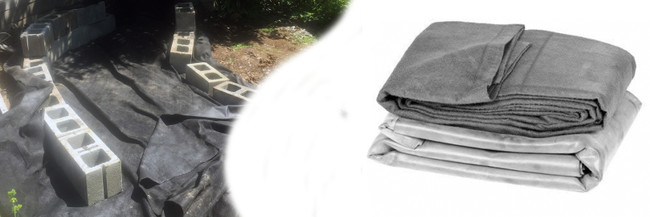Learn why we use Pond Underlayment Every Time we Install a Pond Liner – There are MANY Benefits in Using Underlayment!
Is it Necessary to use Pond Underlayment with my Liner? Keep reading to learn the benefits of installing underlayment when you use pond liner.
There are many ways to get a job done, but we are here to tell you ways that will save you the most trouble. Underlayment is an important part of building your pond and water features. It helps protect your pond liner from being punctured, and more, over time.
What is Pond Underlayment?
Underlayment is a non-woven fabric material, similar to a felt material. It has no bias, or cross-grain, which means that it does not stretch in any direction.
A benefit of using underlayment beneath your pond liner is that it will not allow the liner to stretch.
Why Should I Use Underlayment?
A rubber pond liner is very flexible and will stretch to fit the shape of the hole you lay it in - especially when water is put inside applying pressure in every direction. Weak spots can occur. Water pressure, like air pressure in a balloon, can continue to stretch those areas until they become too thin and burst.
Pond underlayment installed underneath liner will not stretch, therefore stopping the liner from doing so as well. The same flexibility is provided, but with extra resistance.
Laying a liner without the protection of underlayment is taking a huge risk. Roots grow through dirt, rocks migrate with freezing and thawing ground and critters dig without concern for obstacles. All of these can pose a threat from beneath your pond liner.
Can I Use Newspaper or Old Carpet as my Underlayment?
As I said above, there are many ways to get a job done. Many DIY ponds have been installed over the years using old materials like carpet, newspaper or cardboard. The argument is not whether it will last. What I think about is the amount of newspaper or cardboard it would take to create a layer thick enough to keep sharp rocks from getting to the liner. Also, what about tacks and staples from old carpet?
Pond volume is typically measured in gallons by figuring out how many cubic feet make up the hole. There are approximately 7.45 gallons in a cubic foot. Each gallon of water weighs around 8 pounds. That means only one cubic foot of pond water weighs close to 60 lbs. If you have a small 8’ x 10’ pond, that is an average of two feet deep, your pond will hold close to 1,200 gallons of water. That means there is almost 9,600 pounds of pressure being put on your liner when your pond is full of water. That’s a lot of pressure.
What about using Sand as Underlayment?
Sand under the liner is nice for smoothing things out, but how do you make it stick to the sides or form corners around ledges? And doesn’t sand move or displace when you step on it? How will it behave under all that pressure? And when rocks re-surface or roots grow, doesn’t sand just move out of the way? All these variables are enough to make me question whether or not it is worth the risk.
In Summary: I am all about saving a dime here and there, but as an experienced pond installer, I am not willing to take the risk of skimping on the use of underlayment. The light-weight flexibility of pond underlayment coupled with its strength and durability is worth the peace of mind. You know what they say; “you get what you pay for.”
Remember you can count on Hoffman’s Water X Scapes to have quality pond supplies online including supplies like; pond underlayment and fish friendly 45 mil EPDM pond liner, water treatments, pond pumps, pond filtration and more!
